Last Updated on January 9, 2024 by Greg Gillson
I’ve put this resource together for you to answer your question: What birds are in my backyard in South Carolina?
This article lists and discusses the identification of the most common birds in your backyard. The birds chosen in this article are compiled from actual data from the citizen science program eBird. Thus, it is more accurate than some other similar articles you may find on the web. I provide pictures of each bird species mentioned and I’ll tell how to attract them to your backyard.
These are the most common backyard birds in South Carolina:
- Northern Cardinal
- Carolina Wren
- Carolina Chickadee
- Mourning Dove
- Tufted Titmouse
- American Crow
- Northern Mockingbird
- Red-bellied Woodpecker
- Blue Jay
- Eastern Bluebird
- Downy Woodpecker
- House Finch
- Yellow-rumped Warbler
- Pine Warbler
- American Robin
- American Goldfinch
- Eastern Towhee
- Red-winged Blackbird
- Brown Thrasher
- Eastern Phoebe
- Chipping Sparrow
- Common Grackle
- Pileated Woodpecker
- Blue-gray Gnatcatcher
- Brown-headed Nuthatch
- White-throated Sparrow
- Ruby-crowned Kinglet
- Song Sparrow
- Great Crested Flycatcher
South Carolina Birds and Birding in South Carolina State
eBird lists over 450 types of birds as occurring in the state of South Carolina.
The most common bird in South Carolina: the most frequently seen bird in the state is Northern Cardinal. It is reported on 62% of bird watching lists. Birds of South Carolina are typical of birds in the Southeast United States.
If you are serious about knowing the birds native to South Carolina, then check out eBird for South Carolina. It has recent sightings and photos, illustrated checklists with weekly abundance bar charts for state, counties, and individual hotspots of the best birding locations.
If you want to know about other people interested in birds in your area, join a local bird group. The American Birding Association maintains a list of bird watching clubs for each state.
South Carolina Bird Identification
This section is the species accounts. These are designed to help you to recognize birds you see in your backyard. I have used eBird to select the birds that are most common. “Common” means the birds seen most often throughout the year, not necessarily the most numerous.
Each species account starts with a photograph. In the identification section I am using size and shape and bill type before considering the color or patterns on the birds. I find these more reliable when trying to identify an unknown bird. Pay attention to body and tail shape and especially bill shape of birds you see, not just plumage color.
In the section on bird feeders and foods I tell how to attract each species. Not all types of backyard birds will come to feeders. But all backyard birds can be attracted with water. So don’t forget to add a birdbath to your bird feeding station.
Do you live in South Carolina’s Lowcountry? Near the beach? In the Midlands? Coastal South Carolina? Upstate South Carolina? Pee Dee?
To appear in this article, most birds are widely distributed throughout the state and are often year-round residents. However, for those birds that are more localized in place or time, I list the general region and seasonality. Please see the section following these species accounts for the lists of common species by season.
Even if a species is found in a general area, they occur only in the habitat they prefer. So, the exact habitat of your neighborhood is important for the presence of absence of certain kinds of birds.
1. Northern Cardinal (Cardinalis cardinalis)
This is one of the most common and popular backyard birds in the eastern half of the United States.
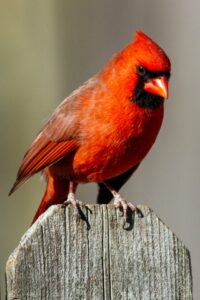
Range in South Carolina: Northern Cardinals are year-round residents throughout South Carolina.
Identification:
Size: Cardinals are a bit smaller than American Robins, about the same size as Red-winged Blackbirds.
Shape: Plump body with fairly long full tail. Wispy crest.
Bill: Short, heavy, conical, pink.
Color: That bright red color is matched by few other birds. Black face. The female is grayer, but with hints of red in wings and tail, and has a crest, too.
Habitat, range & behavior: Cardinals are year-round residents in shrubby woodland edges.
Found from the eastern United States to Texas and Arizona south into Mexico.
That large conical bill is made for chewing seeds. Watch them crack open sunflower seeds, spit out the hulls, and pluck the kernel with their tongues!
Food and feeder preference: Black oil sunflower seeds. Many types of seeds, berries, nuts in larger hopper or tray feeders.
You may like my in-depth article on attracting Northern Cardinals.
2. Carolina Wren (Thryothorus ludovicianus)
This is a fairly common backyard bird in the much of the eastern United States.
 |
| Carolina Wren. theSOARnet from Pixabay. |
Range in South Carolina: Carolina Wrens are year-round residents throughout South Carolina.
Identification:
Size: A smaller bird, between the size of American Goldfinch and House Finch.
Shape: Round body, short neck, flat head, long tail flipped about actively.
Bill: Fairly long, thin, pointed and slightly curved.
Color: Upper parts rusty brown with black bars on the wings and tail. A white eyebrow line and buff under parts.
Habitat, range & behavior: Shrubby thickets and brushy suburban yards.
It is found in the southeastern United States and Yucatan. Northern parts of range expand and contract depending upon harshness of winters.
Males sing throughout the year and are very loud for their size.
Food and feeder preference: Feed mostly on insects and spiders. They will feed on suet.
3. Carolina Chickadee (Poecile carolinensis)
Chickadees are common feeder birds throughout much of North America. This one is common in the southeastern United States.
 |
| Carolina Chickadee. GeorgeB2 from Pixabay. |
Range in South Carolina: Carolina Chickadees are year-round residents throughout South Carolina.
Identification:
Size: This small bid is the size of an American Goldfinch.
Shape: Round body, round head, longer tail.
Bill: Short, straight, stout.
Color: Gray above. Paler below. Black cap, white face, black bib.
Habitat, range & behavior: Lower elevation deciduous forests, wooded residential areas.
This chickadee is a resident in the southeastern US.
Chickadees cannot chew as sparrows do, so they take one large sunflower seed at a time from your feeder and fly off to a branch to pound it open with their stout bills.
Food and feeder preference: Most of their diet is insects, also seeds. They will eat black oil sunflower seeds from hopper feeders.
4. Mourning Dove (Zenaida macroura)
Mourning Doves are the most widespread and most frequent backyard bird in the Lower 48 states of the United States.
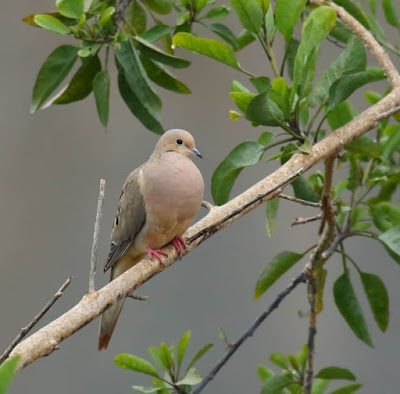 |
| Mourning Dove. Greg Gillson. |
Range in South Carolina: Mourning Doves are year-round residents throughout South Carolina.
Identification: This is a key species for comparing with an unknown bird.
Size: About 12 inches long from bill tip to tail tip. About same size as Northern Flicker. Larger than American Robin. Slightly smaller than domestic city pigeon.
Shape: Very plump with a small round head. Tail is long and pointed. Legs are short.
Bill: Small and rather slender.
Color: Pale brown-pink body, darker wings and tail. White edges on side of tail.
Habitat, range & behavior: Semi-open areas such as urban areas, farmlands, woods. Often seen perched on wires, fences.
It is a resident across the lower-48 states and Mexico, with some movement out of northern areas in winter.
Their mournful cooing is a familiar spring birdsong.
Food and feeder preference: Mourning Doves eat seeds almost exclusively. Attract with black oil sunflower seeds on a large sturdy tray feeder or on the ground.
5. Tufted Titmouse (Baeolophus bicolor)
Related to chickadees, they lack the black bib, but have a crest instead.
 |
| Tufted Titmouse. anne773 from Pixabay. |
Range in South Carolina: Tufted Titmice are year-round residents throughout South Carolina.
Identification:
Size: A small bird, but a large titmouse, this species is larger than chickadees, about the size of a junco or House Finch.
Shape: Rounded body, long full tail, big head, long legs.
Bill: Short and stout, compressed (taller than wide), black.
Color: Dark blue-gray above, pale below. Black feathers around eye accentuates its size.
Habitat, range & behavior: Lives in deciduous forests with heavy canopy, parks.
Found in eastern and southeastern United States is expanding its range north and west.
Backyard bird feeders might be helping this species expand its range northward.
Food and feeder preference: Insects and seeds. At your hopper or tray feeder they like black oil sunflower seeds and suet.
6. American Crow (Corvus brachyrhynchos)
This larger all-black bird is common in cities and country. Its cawing call is familiar to most people.
 |
| American Crow. Greg Gillson. |
Range in South Carolina: American Crows are year-round residents throughout South Carolina.
Identification: This is a key species for comparing with an unknown bird.
Size: About 17-1/2 inches long from bill tip to tail tip, though there is much size variation throughout its range. Larger than blackbirds and grackles. Smaller than ravens.
Shape: Thick neck, large head, rather short square-ended tail. Longer legs. In flight has rounded wing tips with each primary feather separated from others forming “fingers.”
Bill: As long as head, thick, black.
Color: Glossy black throughout.
Habitat, range & behavior: They prefer open areas with trees, fields, farms, cities.
They are common across most of the United States lower-48, except in the desert southwest. They move into southern Canada in summer.
They gather in evening communal roosts in large flocks that may number into the thousands and then move out at dawn into the surrounding area.
Food and feeder preference: Omnivorous, they feed on large insects, grain, small mammals, carrion. You probably don’t want these large entirely black birds in your backyard feeders. So don’t feed table scraps to birds.
7. Northern Mockingbird (Mimus polyglottos)
This bird sings from exposed perches most of the year and often through the night. They have an unending supply of their own unique short phrases that they repeat about 3 times each, but frequently intersperse songs of other birds.
 |
| Northern Mockingbird. Greg Gillson. |
Range in South Carolina: Northern Mockingbirds are year-round residents throughout South Carolina.
Identification:
Size: The length of an American Robin.
Shape: Slender and long tailed. Long legs.
Bill: Medium length, slender, slightly curved.
Color: Gray, darker above, with white patches in wing and tail.
Habitat, range & behavior: They prefer edge habitat with scattered trees and bushes, parks and residential areas.
It is found in eastern and southern parts of the US, West Indies, and south into Mexico. In summer birds are found a bit farther north.
They boldly defend their nests from other birds, cats, and intruders.
Food and feeder preference: Eats insects, berries, and fruit. You may attract mockingbirds to your feeder with grapes, raisins, apple slices. They will come to a suet block. They readily use a bird bath.
8. Red-bellied Woodpecker (Melanerpes carolinus)
This is one of the most common species in the eastern half of the United States.
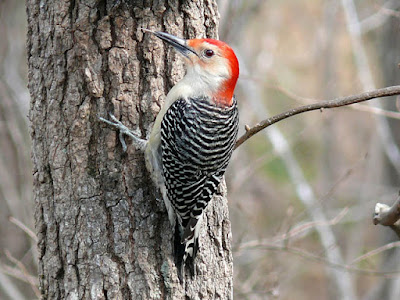 |
| Red-bellied Woodpecker. skeeze from Pixabay. |
Range in South Carolina: Red-bellied Woodpeckers are year-round residents throughout South Carolina.
Identification:
Size: Fairly large for a backyard bird. Between a Starling and American Robin in size. Smaller than a Northern Flicker.
Shape: Stout with large head and short tail. Clings to tree trunk on strong short legs propped up with short stiff tail.
Bill: Long, chisel shaped.
Color: Pale gray body, many thin black-and-white bars across back and wings. Red nape, extending forward on crown on male.
Habitat, range & behavior: These birds are found in many woodland types, including oak, hickory and pine.
They are found from the eastern slope of the Rocky Mountains in the lower-48 states from Texas to extreme southern Canada, and eastward from Florida northward just to the southern edge of the New England states.
In typical woodpecker fashion, it hitches up the tree trunk and larger branches.
Food and feeder preference: This species eats insects and nuts. They may eat peanuts from a tray feeder and eat from a suet block.
9. Blue Jay (Cyanocitta cristata)
A common and well-known bird in the eastern half of the United States.
 |
| Blue Jay. skeeze from Pixabay. |
Range in South Carolina: Blue Jays are year-round residents throughout South Carolina.
Identification:
Size: About that of American Robin.
Shape: Fluffy, large crested head, ample tail. Large strong legs.
Bill: Black, long and stout.
Color: Blue above, white below. Black neck collar. White patches in wing.
Habitat, range & behavior: Woodlands and towns.
Found in the eastern half of the United States. In summer into southern Canada.
Bold and brash. May bully smaller birds. Jays gulp lots of seeds or other food at once, storing it in their crop. Then they fly off and bury food items in a hidden cache.
Food and feeder preference: Omnivorous. They can quickly empty your feeder! Because they are also aggressive toward other feeder birds, some people put mesh cages around smaller bird feeders. Small birds can go through, squirrels and larger “pest” birds are prevented entry. Some people feed jays peanuts, perhaps away from the seed feeders.
10. Eastern Bluebird (Sialia sialis)
A beloved bird of open fields with trees and fence lines for perching.
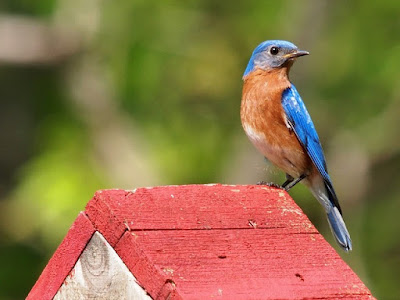 |
| Eastern Bluebird. skeeze from Pixabay. |
Range in South Carolina: Eastern Bluebirds are year-round residents throughout South Carolina.
Identification:
Size: Larger than House Finches. Much smaller than starlings. About length of White-crowned Sparrow but differently proportioned.
Shape: Chunky, large head, short tail.
Bill: Straight, fairly slender, curved at tip.
Color: Males are brilliant blue above (including wings and tail), rusty orange below with white belly and under tail. Females are often much paler, almost grayish.
Habitat, range & behavior: Found in pasture, fields, golf courses, open woodland edges.
They are resident in most of eastern US, highlands of Middle America. In summer reach northernmost eastern US and southernmost eastern Canada, withdrawing somewhat in winter.
They readily use nest boxes, but the entrance hole must be smaller than the head of a starling, and without a perch.
Food and feeder preference: They eat flying insects primarily, but also other invertebrates and berries. They will eat mealworms at your feeder and frequent birdbaths.
11. Downy Woodpecker (Dryobates pubescens)
This tiny woodpecker is found across the United States.
 |
| Downy Woodpecker. Greg Gillson. |
Range in South Carolina: Downy Woodpeckers are year-round residents throughout South Carolina.
Identification:
Size: Bigger than a junco or House Finch. Smaller than a Red-winged Blackbird. About the same size as a White-crowned Sparrow, but with a much shorter tail.
Shape: Stocky with large head and short stiff tail.
Bill: Short, chisel shaped.
Color: Black-and-white striped head. Black wings with white spots. Solid white back. White under parts. Black tail with white outer tail feathers with black bars or spots. Male with small red spot at back of head.
Habitat, range & behavior: Found in small deciduous trees, willows, and even weed stocks such as teasel, especially near water.
Ranges coast-to-coast across all but northernmost parts of Canada and Alaska south to the southern US. Absent in the desert southwest.
Interestingly, I learned today that the males may more often be found in smaller plants and twigs, while females are more likely on tree trunks.
Food and feeder preference: Insects, fruits, and seeds. Gleans arthropods from the bark of trees. Attract with suet feeder. Will also eat black oil sunflower seeds.
12. House Finch (Haemorhous mexicanus)
Originally a bird of the West, now found across most of the US. There are other red finches, but these are the ones most likely in residential areas.
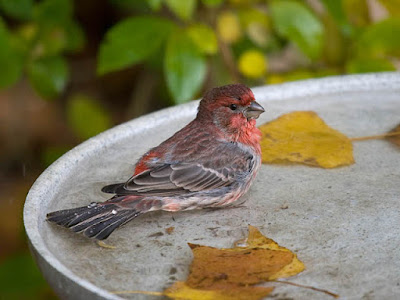 |
| House Finch. Greg Gillson. |
Range in South Carolina: House Finches are year-round residents throughout South Carolina.
Identification: This is a key species for comparing with an unknown bird.
Size: About 6 inches from bill tip to tail tip. Larger than goldfinches and chickadees. Smaller than a White-crowned Sparrows or Spotted/Eastern towhees.
Shape: Medium build with a medium-long notched tail. Round head.
Bill: Short, conical.
Color: Brown and gray above with streaks on the sides of the pale underparts. Males with red (sometimes orange or rarely yellow) crown, chest, rump.
Habitat, range & behavior: You’ll find small flocks on wires, in short treetops and in bushes. Originally deserts and grasslands. Rural areas and towns are where they’re now most common.
Formerly found in the western United States and Mexico. Then introduced into the northeastern United States, but now found in nearly all of the lower-48 states and extreme southern Canada. Rare in plains states (Dakotas to Texas) and southern Florida.
House Finches are not territorial, but males sing throughout the year–a lively, wiry song ending in a couple of buzzy notes.
Food and feeder preference: They love sunflower seeds and tube feeders. May eat from thistle socks.
You may like my in-depth article on attracting House Finches.
13. Yellow-rumped Warbler (Setophaga coronata)
An abundant winter visitor in southern US to treetops and weedy areas.
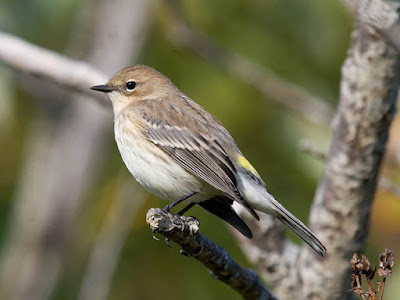 |
| Yellow-rumped Warbler. Greg Gillson. |
Range in South Carolina: Yellow-rumped Warblers are winter visitors throughout South Carolina.
Identification:
Size: Small, they are a bit larger than chickadees and goldfinches. They are smaller than House Finches and juncos.
Shape: Plump and neckless with a shorter tail.
Bill: Short, slender, straight, pointed.
Color: Breeding plumage in spring is blue-gray on the upper parts, black sides and chest, yellow rump, yellow on sides. Two forms: western form with yellow throat and large white wing patch; eastern and northern form with white throat and two white wing bars. In winter plumage both forms are gray-brown above, pale cream below. Yellow rump and white tail corners in flight.
Habitat, range & behavior: In breeding season mostly in coniferous or mixed forests, in mountains in west. In winter open areas with fruiting shrubs and scattered trees.
Breed across Canada and Alaska and in conifer forests in the west. Winter along both coasts and the southern states through Middle America. There are also non-migratory forms in Mexico and Guatemala.
They tend to forage in outer branches about half way up the tree.
Food and feeder preference: Mainly insects in the summer, they switch to waxy berries and fruit in winter. They are thus able to winter farther north than other warblers. They are attracted to suet feeders.
14. Pine Warbler (Setophaga pinus)
These well-named birds are residents in the Southeast and early spring migrants in the East.
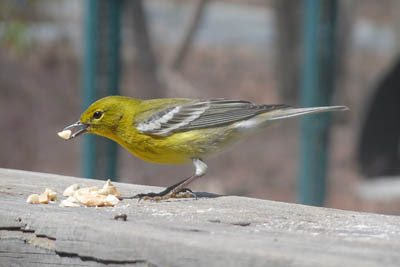 |
| Pine Warbler. Nikolaus Schultz from Pixabay. |
Range in South Carolina: Pine Warblers are year-round residents throughout South Carolina.
Identification:
Size: A smaller bird, a little longer than a goldfinch.
Shape: These birds have a typical warbler shape, compact with a longer tail.
Bill: Fairly long, sharply pointed.
Color: These are kind of a dull yellowish-green on the head and back. The breast is more yellowish, especially in males. There are some dull greenish streaks on the breast. The wings and tail are rather gray, with two bold white wing bars. The under tail covert and lower belly is white.
Habitat, range & behavior: Almost always found in pines.
Year-round resident in the Southeast; summer resident in the eastern United States northward to southernmost Canada.
Tend to stay high in the pines, where often detected by their dry trilled song.
Food and feeder preference: Usually insects. However, these are on of the few warblers to eat seeds. They will feed on millet and sunflower seeds at hopper feeders. Also eat suet.
15. American Robin (Turdus migratorius)
This familiar bird is a resident in the northern half of the United States and a winter visitor in the southern half.
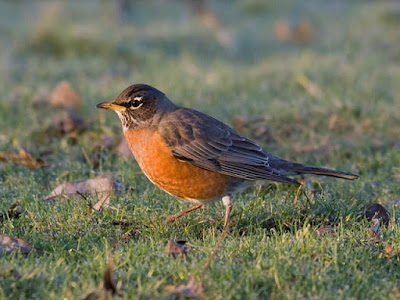 |
| American Robin. Greg Gillson. |
Range in South Carolina: American Robins are year-round residents throughout South Carolina.
Identification: This is a key species for comparing with an unknown bird.
Size: 10 inches long from bill tip to tail tip. About the same size as a Blue Jay or one of the Scrub-Jays. Larger than Red-winged Blackbird. Smaller than a Mourning Dove.
Shape: Very plump with a fairly long tail.
Bill: Straight and fairly slender, curved at the tip.
Color: Gray-brown upperparts, rusty orange breast.
Habitat, range & behavior: Open woodlands, farmlands, urban parks and lawns.
Migratory, breeds north across Alaska and Canada. Resident in most of the United States (lower 48). Winters in the United States, Mexico, to central America.
Hops on your lawn turning head this way and that looking for food. Their caroling song is one of the early signs of spring in the north.
Food and feeder preference: American Robins eat earthworms and other invertebrates in the lawn. May eat fruit from a tray feeder or the ground. Eat small berries from trees and bushes.
16. American Goldfinch (Spinus tristis)
A beautiful tiny finch familiar to many in its bright yellow summer plumage. Colloquially called a “wild canary.”
 |
| American Goldfinch. Greg Gillson |
Range in South Carolina: American Goldfinches are year-round residents in western South Carolina, winter visitors throughout.
Identification: This is a key species for comparing with an unknown bird.
Size: Very small at about 5 inches from bill tip to tail tip. Similar in size to a chickadee. Larger than hummingbirds. Smaller than juncos and House Finches.
Shape: Tiny, somewhat plump with larger head and short tail.
Bill: Short, conical, pink.
Color: Males in summer are bright lemon yellow with black forehead and black wings and tail with white bars. White under tail coverts. Females are dull olive, wings and tail browner. Winter birds are pale grayish-yellow with tan and brown wings and tail.
Habitat, range & behavior: This species is found in weedy fields and similar clearings with thistles and similar plants.
It is found coast-to-coast throughout the year across most of the middle lower-48 states. In summer moves north to the Canada border. In the winter found south to the Mexico border.
The flight is highly undulating, rising and falling as they flap in short bursts.
Besides a long, sweet lilting song, they call in flight a lilting 4-part: “potato chip!”
Food and feeder preference: Feeds on weed seeds, thistle seed. May eat black oil sunflower seeds from tube feeder. Love Nyjer seed in a feeder called a “thistle sock.”
You may like my in-depth article on attracting American Goldfinches.
17. Eastern Towhee (Pipilo erythrophthalmus)
These birds were formerly lumped with Spotted Towhee as one species, Rufous-sided Towhee. Together they were found across the United States, they now split the country in half, east and west
 |
| Eastern Towhee. Skeeze from Pixabay. |
Range in South Carolina: Eastern Towhees are year-round residents throughout South Carolina.
Identification:
Size: Just a bit larger than a White-crowned Sparrow.
Shape: Chunky or pot-bellied with a big round head and full rounded tail.
Bill: Stout and conical.
Color: Black hood and upper parts, including tail. White wing path. White tail corners. Rusty sides. White belly. Females replace the black with dark brown.
Habitat, range & behavior: Brushy woodland edges. Tangles.
Breeds throughout the eastern United States and adjacent southernmost Canada. Northern populations migrate out of the northern US to the Southeast.
These birds spend much of their time on the ground, kicking up leaf litter with both feet in a hop-kick.
Food and feeder preference: These birds eat a wide variety of insects, beetles, berries, and seeds. They will feed on the ground under your feeder or on platform feeders. They like black oil sunflower seeds and other seeds.
18. Red-winged Blackbird (Agelaius phoeniceus)
These noisy flocking birds are most often found in marshes. But in winter they are found in backyards.
 |
| Male Red-winged Blackbird. Greg Gillson. |
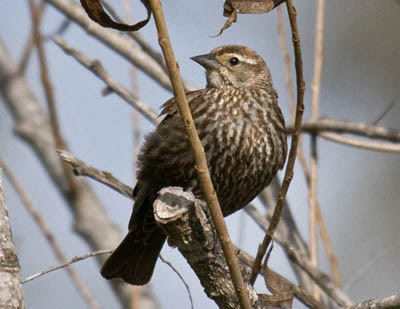 |
| Female Red-winged Blackbird. Greg Gillson. |
Range in South Carolina: Red-winged Blackbirds are year-round residents throughout South Carolina.
Identification: This is a key species for comparing with an unknown bird.
Size: About 8-3/4 inches long from bill tip to tail tip. About the size of a Northern Cardinal. Smaller than an American Robin.
Shape: Pot-bellied with a longer bill and flat forehead. Tail average.
Bill: Long and sharp pointed.
Color: Males are black with red and yellow shoulder patch. Females are streaked brown and rusty (sparrow-like but pointed bill and flat forehead).
Habitat, range, and behavior: Cattail marshes and wetlands are their summer habitat. In winter they feed in grain fields.
They breed across most of the North American continent. In winter they withdraw from most of Alaska and Canada.
They are found in colonies in summer and large flocks in winter.
Food and feeder preference: They eat insects in summer. In winter they eat grain and seeds. They visit feeders, more often in large winter flocks, and eat most seeds and suet.
19. Brown Thrasher (Toxostoma rufum)
These birds are accomplished singers, with over 1100 different songs recorded!
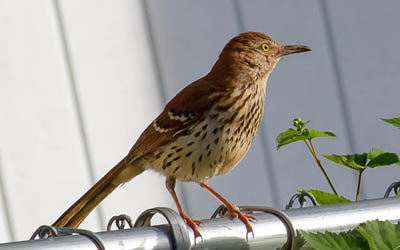 |
| Brown Thrasher. Linda Jones. CC0. |
Range in South Carolina: Brown Thrashers are year-round residents throughout South Carolina.
Identification:
Size: Longer than a robin, smaller than a flicker.
Shape: Pot-bellied. Long tail with rounded tip. Large head.
Bill: Long and thin, slightly curved down.
Color: Rusty above. Gray face. Heavy rusty streaks below on cream-colored under parts. Two white wing bars.
Habitat, range & behavior: These birds live in woodland edges and hedges.
They are year-round residents in the Southeast. In summer they also breed northward, east of the Rocky Mountains to southern Canada.
You may find them feeding on the edge of lawns with a very horizontal posture. They may mimic other bird songs and calls.
Food and feeder preference: They primarily eat insects and invertebrates. But they will also come to platform feeders for sunflower seeds, nuts, suet, berries.
20. Eastern Phoebe (Sayornis phoebe)
This plain bird is common in backyards in the East.
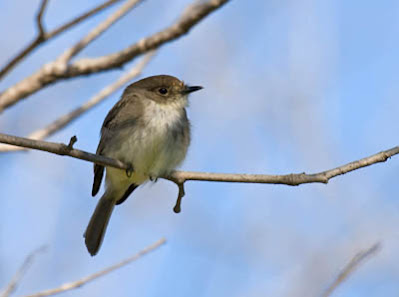 |
| Eastern Phoebe. Greg Gillson. |
Range in South Carolina: Eastern Phoebes are year-round residents throughout most of South Carolina, winter visitors only along the coast.
Identification:
Size: About the size of bluebirds. Larger than House Sparrows.
Shape: Rather stout, with long wings, medium-length tail. Pointed but flat bill. Upright posture.
Bill: Black, pointed, wide and flat.
Color: Brownish-gray above, slightly yellow-olive on sides. White under tail coverts. No eye ring or wing bars help distinguish them from some other flycatchers.
Habitat, range & behavior: Found in woodlands, suburbs, farms. Frequently nest in rafters, under eaves, porches.
They are summer residents east of the Rocky Mountains from Canada southward. Year-round residents through the interior of the Southeast, to Texas. Winter visitor to Gulf Coast and southern Atlantic.
Phoebes pump their tail down. They also frequently spread their tails.
Food and feeder preference: They eat flying insects that they catch on the wing. Not a feeder visitor.
21. Chipping Sparrow (Spizella passerina)
Chipping Sparrows are a widespread species adapted to human disturbance. They are rather tame. They are frequently found in cemeteries with large trees.
 |
| Chipping Sparrow. Greg Gillson. |
Range in South Carolina: Chipping Sparrows are summer residents throughout South Carolina and winter visitors along the coast.
Identification:
Size: These are small sparrows, bigger than goldfinches or chickadees, but smaller than House Finches or Song Sparrows.
Shape: Plump and fairly long tailed.
Bill: Short and conical.
Color: Striped brown and dark brown above. Grayish under parts. Black line through eye. Crown streaked in winter but in summer becomes solid chestnut. Two white wing bars.
Habitat, range & behavior: Grassy open conifer woodlands with some shrubs, parks, orchards.
Breeds from Alaska, across Canada and south into highlands of Middle America. In winter retreats from northern areas to southern United States and northern Mexico.
In summer solitary or in pairs. In winter they forage in flocks of up to 50 birds.
Food and feeder preference: Weed seeds, supplemented with insects in summer. They may eat black oil sunflower seeds in your feeder, but more likely will feed on mixed seeds on the ground under the feeder.
22. Common Grackle (Quiscalus quiscula)
Sometimes considered a pest to crops, grackles are longer and lankier than very similar blackbirds.
 |
| Common Grackle. GeorgiaLens from Pixabay |
Range in South Carolina: Common Grackles are year-round residents in South Carolina.
Identification:
Size: Larger than Red-winged Blackbirds, they are near the length of Mourning Doves.
Shape: Long, with long full keel-shaped tail, long legs, flat crown.
Bill: Longer than head, pointed, but stouter than other blackbirds.
Color: Glossy black with hint of bronze or green on head (depending upon population). Yellow eye.
Habitat, range & behavior: They are found in agricultural areas, woodland edges, city parks and lawns.
Resident in the southeastern United States. In summer they migrate northward and west to the central United States and Canada.
They monopolize feeders and are bullies toward other birds.
Food and feeder preference: Grain, corn, acorns, small aquatic fish and amphibians. To discourage them, use tube feeders, rather than hopper or tray feeders. Don’t over-feed, keep spilled seed picked up.
23. Pileated Woodpecker (Dryocopus pileatus)
This huge woodpecker is found in large timber.
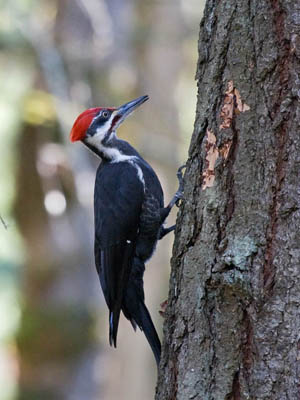 |
| Pileated Woodpecker. Greg Gillson. |
Range in South Carolina: Pileated woodpeckers are year-round residents throughout South Carolina.
Identification:
Size: Large; the size of a crow. Bigger than a flicker.
Shape: Heavy body with a fairly long neck for a woodpecker. Big head, accentuated by large bill and flamboyant crest. Broad rounded wings. Short, wedge-shaped tail.
Bill: As long as head. Strong and chisel shaped.
Color: Primarily black with white stripe on neck and face. Red crest. White underwing linings. White bases to the upper primaries.
Habitat, range & behavior: Found in dense mature forests with big trees.
They are found across Canada, conifer forests of the West Coast, and most of the East.
Drill with powerful strikes of their bill on trees live or dead. Look for their large rectangular holes in huge old stumps.
Food and feeder preference: Carpenter ants are their primary food. They will eat sunflowers and peanuts on platform feeders.
24. Blue-gray Gnatcatcher (Polioptila caerulea)
These small birds creep through the bushes, staying hidden.
 |
| Blue-gray Gnatcatcher. Greg Gillson. |
Range in South Carolina: Blue-gray Gnatcatchers are summer residents throughout most of South Carolina, year-round residents near the coast.
Identification:
Size: Small bird smaller than House Finch.
Shape: Long tail and long legs. Short neck.
Bill: Short and thin.
Color: Blue gray above, white below. Upper tail black; under tail mostly white.
Habitat, range & behavior: Found in conifer woods and shrubby habitats.
They breed throughout most of the eastern United States and across the southern US. In the winter along the coast from Virginia to California.
They crawl and hop through dense vegetation flipping their long tail about and calling softly.
Food and feeder preference: They eat insects and generally don’t come to feeders.
25. Brown-headed Nuthatch (Sitta pusilla)
These birds are restricted to pine forests in the Southeast.
 |
| Brown-headed Nuthatch. mlmclaren from Pixabay. |
Range in South Carolina: Brown-headed Nuthatches are year-round residents throughout South Carolina.
Identification:
Size: Very small bird. Smaller than American Goldfinch.
Shape: Plump with large head on short neck. Tiny tail. Big feet.
Bill: short and sharp pointed.
Color: Gray above with darker wings. Brown crown. White throat and under parts.
Habitat, range & behavior: Found in open stands of old pure pine.
They are residents in the southeastern United States.
They crawl over bark of trunk and branches–even upside down.
Food and feeder preference: They eat insects and may come to feeders for suet or small seeds.
26. White-throated Sparrow (Zonotrichia albicollis)
A fairly common bird of northern forests that visits backyards across much of the US.
 |
| White-throated Sparrow. Greg Gillson. |
Range in South Carolina: White-throated Sparrows are winter visitors throughout South Carolina.
Identification:
Size: Similar in size to White-crowned Sparrow. Bigger than a House Finch; smaller than a starling.
Shape: Longer body. Round head on short neck. Long tail with notched tip.
Bill: Short. conical.
Color: Striped tan and brown above, pale gray below. White-striped form with black and white head stripes. Tan-striped form with tan and brown striped head. First year birds are similar to tan-stiped adults, but streakier overall. Yellow spot between eyebrow and bill. White throat strongly offset from gray breast and face.
Habitat, range & behavior: Found in forests, brush, and open woodland edges.
Breeds across Canada and northernmost Eastern United States. Winters in the eastern US, southern central US, and rare but regular along the West Coast.
Found in small flocks on ground near brush into which they can flee. Kick up leaves to search under for food.
Food and feeder preference: Eat seeds and berries in winter, more insects and fruit in summer. In your feeder will eat mixed seeds on a platform feeder and on the ground.
27. Ruby-crowned Kinglet (Regulus calendula)
These tiny little hyperactive balls of feathers are very similar in appearance to sluggish Hutton’s Vireos. Note the yellow feet and skinny black legs of the kinglet.
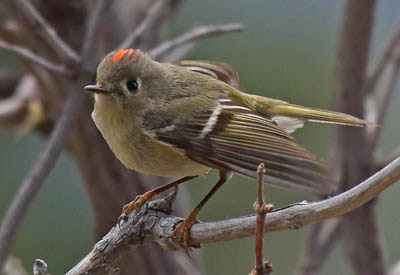 |
| Ruby-crowned Kinglet. Greg Gillson. |
Range in South Carolina: Ruby-crowned Kinglets are winter visitors throughout South Carolina.
Identification:
Size: Smaller than a chickadee or goldfinch.
Shape: Plump, almost round body with round head merging into the body almost without neck. Very short tail. Thin legs.
Bill: Very short, rather thin.
Color: Olive-green, tending toward gray, especially on the head. Paler yellow-green below. Wing gray with yellow-green edges to the wing feathers. Two white wing bars with distinctive black panel below the lower wing panel. White eye ring slightly broken on top and bottom. Red crown of male only shows when agitated. Legs very thin, black, with obvious yellow soles to the feet.
Habitat, range, and behavior: Mountain conifers in summer, brushy patches and chaparral in winter. Residential landscaping hedges and bushes.
Breeds in Alaska, across Canada, and mountains of the West. Migrates through all of US. Winters in coastal East, Southeast, West, into Mexico.
Active flitting from branch to branch, in interior of bushes and small trees, in short flap-hops. Constantly twitches wings. Hover-gleans at leaf tips.
Food and feeder preference: Ruby-crowned Kinglets feed in bushes next to house looking for spiders and insects. May eat at suet feeder.
28. Song Sparrow (Melospiza melodia)
A common bird, but variable, and similar to many other streaked brown sparrows.
 |
| Song Sparrow. Greg Gillson. |
Range in South Carolina: Song Sparrows are year-round residents throughout South Carolina.
Identification:
Size: A smaller bird, similar in size to House Finch and juncos. Larger than chickadees and goldfinches. Smaller than White-crowned Sparrows or Spotted/Eastern towhees.
Shape: Plump with round head, long rounded tail.
Bill: Short, conical.
Color: Highly variable in darkness and color saturation across its range (dark rusty to pale gray). Generally gray-brown above with dark brown streaking on back. Complicated head pattern. Streaking on sides and breast converge into dense central breast spot.
Habitat, range & behavior: Thickets, especially near water. Backyard shrubbery.
Resident in western United States, western Canada, coastal southern Alaska, northeastern US. In summer also moves into mid-Canada and northern half of US. In the winter found in most of the US lower-48. Also, a population in central Mexico.
Forages on ground, never far from low cover to which they fly if startled.
Food and feeder preference: Song Sparrows feed on seeds and insects near the ground. Will visit hopper and tray feeders for mixed bird seed.
29. Great Crested Flycatcher (Myiarchus crinitus)
These larger flycatchers feed toward the top of the canopy within woods.
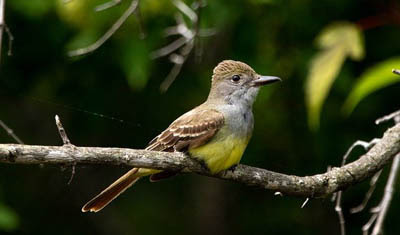 |
| Great Crested Flycatcher. Simard Francois from Pixabay. |
Range in South Carolina: Great Crested Flycatchers are summer residents throughout South Carolina.
Identification:
Size: These are fairly large flycatchers, about the size of Red-winged Blackbirds. They are much smaller than robins.
Shape: Lanky, these birds have long full tails and big heads.
Bill: The bill is fairly long and stout. Wide and pointed.
Color: Fairly dull green-brown back, wings, tail. Gray head and upper breast. Yellow belly and under tail coverts. Thin dull wing bars. Undertail is rusty orange.
Habitat, range & behavior: They stick to the upper parts of trees in broken woodlands.
They are summer residents throughout the East, and adjacent southern Canada. Most winter in Central America, though there are some all year in southern Florida.
These birds nest in cavities, so will accept nest boxes, such as those for bluebirds.
Food and feeder preference: They eat insects and fruits. They probably will not come to feeders.
Common Birds in South Carolina
To determine how common each species is I used the data from actual bird sightings from the citizen science program eBird. Birds are listed by frequency. That is, how often the species is recorded on checklists submitted to eBird (a percentage).
When choosing the birds to include in this article I leaned strongly to birds that are present throughout the year in good numbers. Thus, many of the common birds are year-round residents. This means that they live in the same location all year. They raise their young in your neighborhood. They don’t migrate. Or if the species does migrate, the ones living in your area don’t. If this is the case, some migrants may move into your area during certain times of year, adding to the same species that are in your yard full time.
Some migrant birds visit your yard during the “summer.” Often, they arrive in spring and remain until late fall. They nest and raise their young in your neighborhood. These are the summer residents.
Other migrant birds visit your backyard during the “winter.” Some of these winter visitors may arrive in July and remain into April. Others may only be found in the cold of December or January. They key here is that they nest and raise their young somewhere else. They only visit your yard in the non-breeding season.
Migration is an amazing spectacle.
There will be birds that fly through your region in spring or fall (or both). They may visit your backyard only a few days or weeks a year. They aren’t regular enough, or stay long enough, to be included in this article. But the number of briefly visiting migrant birds could double the number of species presented here. You may see them over time. Consult checklists in eBird for your county to see what is possible.
I have generally excluded common waterfowl, birds of prey, shorebirds, seabirds, and others that aren’t usually found in residential areas. But they may certainly fly over or be seen regularly if your home is on a shoreline, for instance.
Most common backyard birds in South Carolina throughout the year
The following list is the backyard birds that are, on average, most common throughout the entire year. The list is ordered by most common based on the frequency of how often each species is recorded on checklists submitted to eBird.
- Northern Cardinal (61% frequency)
- Carolina Wren (48%)
- Carolina Chickadee (44%)
- Mourning Dove (41%)
- Tufted Titmouse (41%)
- American Crow (38%)
- Northern Mockingbird (36%)
- Red-bellied Woodpecker (36%)
- Blue Jay (35%)
- Eastern Bluebird (27%)
- Downy Woodpecker (25%)
- House Finch (23%)
- Yellow-rumped Warbler (21%)
- Pine Warbler (19%)
- American Robin (19%)
- American Goldfinch (19%)
- Eastern Towhee (19%)
- Red-winged Blackbird (19%)
- Brown Thrasher (18%)
- Eastern Phoebe (16%)
- Chipping Sparrow (16%)
- Common Grackle (15%)
- Pileated Woodpecker (13%)
- Blue-gray Gnatcatcher (13%)
- Brown-headed Nuthatch (13%)
Most common backyard birds in South Carolina in winter
- Northern Cardinal (57% frequency)
- Carolina Chickadee (47%)
- Carolina Wren (44%)
- Tufted Titmouse (41%)
- Mourning Dove (39%)
- Yellow-rumped Warbler (38%)
- American Crow (37%)
- Red-bellied Woodpecker (36%)
- Northern Mockingbird (35%)
- Blue Jay (32%)
- White-throated Sparrow (29%)
- Eastern Bluebird (28%)
- Ruby-crowned Kinglet (27%)
- American Robin (26%)
- Downy Woodpecker (26%)
- American Goldfinch (25%)
- House Finch (23%)
- Song Sparrow (20%)
- Eastern Phoebe (20%)
- Red-winged Blackbird (20%)
Most common backyard birds in South Carolina in summer
- Northern Cardinal (62% frequency)
- Carolina Wren (47%)
- Mourning Dove (44%)
- Carolina Chickadee (36%)
- Tufted Titmouse (35%)
- Northern Mockingbird (33%)
- American Crow (32%)
- Blue Jay (30%)
- Red-bellied Woodpecker (29%)
- Eastern Bluebird (23%)
- House Finch (23%)
- Downy Woodpecker (22%)
- Great Crested Flycatcher (20%)
- Red-winged Blackbird (20%)
How do birds differ between winter and summer?
Carolina Chickadees, Yellow-rumped Warblers, White-throated Sparrows, Ruby-crowned Kinglets are more common in winter than summer.
Blue-gray Gnatcatchers, Brown Thrashers, Great Crested Flycatchers are more common in summer than winter.
Common Backyard Birds of Charleston, South Carolina
 |
| Carolina Wren. theSOARnet from Pixabay |
Birds in Myrtle Beach are similar to those in Charleston.
- Northern Cardinal (57% frequency)
- Carolina Wren (49%)
- Carolina Chickadee (45%)
- Northern Mockingbird (39%)
- Mourning Dove (39%)
- American Crow (37%)
- Blue Jay (37%)
- Tufted Titmouse (37%)
- Red-bellied Woodpecker (35%)
- Yellow-rumped Warbler (29%)
- Downy Woodpecker (26%)
- Eastern Bluebird (24%)
- House Finch (20%)
Backyard birds in Charleston are very similar to birds in the rest of the state as a whole. There are many common herons and water birds in the Charleston area that are less common in the rest of the state.
Common Backyard Birds of Columbia, South Carolina
- Northern Cardinal (74% frequency)
- Carolina Wren (63%)
- Carolina Chickadee (59%)
- Tufted Titmouse (55%)
- Mourning Dove (50%)
- Red-bellied Woodpecker (50%)
- Blue Jay (39%)
- Northern Mockingbird (37%)
- American Crow (36%)
- American Robin (33%)
- Downy Woodpecker (33%)
- House Finch (31%)
- Pine Warbler (27%)
- Brown-headed Nuthatch (27%)
- White-throated Sparrow (27%)
- Yellow-rumped Warbler (26%)
- Eastern Towhee (26%)
- Ruby-crowned Kinglet (25%)
- Eastern Bluebird (24%)
- Brown Thrasher (21%)
- Pileated Woodpecker (20%)
The top 6 most common birds on this list are the same as those most common in the state as a whole but are seen more frequently than other locations.
American Robins, Pine Warblers, Brown-headed Nuthatches, House Finches are more common in Columbia than elsewhere in the state, on average.
Common Backyard Birds of Greenville, South Carolina
- Northern Cardinal (68% frequency)
- Carolina Wren (57%)
- Carolina Chickadee (54%)
- Tufted Titmouse (52%)
- Mourning Dove (52%)
- American Crow (46%)
- Blue Jay (44%)
- Eastern Bluebird (43%)
- Red-bellied Woodpecker (41%)
- House Finch (37%)
- American Goldfinch (37%)
- Downy Woodpecker (36%)
- Northern Mockingbird (36%)
- American Robin (35%)
- Eastern Towhee (31%)
- Brown Thrasher (30%)
- Eastern Phoebe (29%)
- White-breasted Nuthatch (27%) Learn about this species on eBird
- White-throated Sparrow (24%)
- Common Grackle (21%)
Some of the common birds in Greenville are different than elsewhere in South Carolina.
Carolina Wrens and Tufted Titmice are especially common.
White-breasted Nuthatches, Eastern Bluebirds, House Finches, American Goldfinches, Eastern Towhees, American Robins, Brown Thrashers, Eastern Phoebes are more common in Greenville than the state average.
Wrapping Up
There are certainly some lovely birds to see right in your own backyard but there is also plenty to see further afield. Here is my pick:
Coastal areas:
- Laughing gulls: Noisy beach bums, easily recognizable by their black heads and yellow bills.
- Brown pelicans: Graceful divers, often seen skimming the waves for fish.
- Osprey: Large birds of prey with hooked beaks, often perched on poles or soaring above the water.
- Great blue herons: Tall wading birds with long necks and pointed beaks, found in marshes and shallow water.
- Common terns: Elegant black-and-white birds with forked tails, flitting along the shoreline.
Forests and woodlands:
- Northern cardinals: Vibrant red songbirds with black masks, common backyard visitors.
- Carolina wrens: Small brown birds with loud, melodic songs, often hiding in bushes.
- Tufted titmice: Gray birds with black button eyes and a crest, flitting through branches.
- Red-tailed hawks: Soaring raptors with broad wings and reddish tails, perched on high branches.
- Wild turkeys: Large ground birds with distinctive fan tails, sometimes seen in flocks.
Fields and open areas:
- American robins: Familiar songbirds with red breasts and gray backs, hopping on lawns and eating berries.
- Mourning doves: Gray birds with mournful cooing calls, often seen perched on wires or feeding on the ground.
- Eastern bluebirds: Beautiful blue birds with reddish chests, nesting in cavities and feeding on insects.
- Killdeer: Large plovers with loud, piercing calls, running and stopping on the ground.
- Common grackles: Blackbirds with iridescent purple heads, often seen in large flocks in open areas.
Frequently Asked Questions
What is the state bird of South Carolina?
The proud state bird of South Carolina is the Carolina wren (Thyrothorus ludovicianus)! This lively little songbird dons a rufous-red back, a white eyebrow stripe, and a finely barred black tail. They’re known for their loud, complex songs, which can be heard year-round, earning them the nickname “the mockingbird of the north.”
The Carolina wren was chosen as the state bird in 1948, replacing the mockingbird. This shift was partially due to the fact that the Carolina wren’s name includes “Carolina,” adding a sense of local pride. Moreover, their permanent residence throughout the state and their cheerful singing resonated with South Carolinians.
These curious wrens are common sights in a variety of habitats across the state, from forests and woodlands to backyards and gardens. They readily build nests in cavities and crevices, including human-made structures like birdhouses and mailboxes. Their adaptability and resilience make them well-suited to life in South Carolina, and their vibrant personalities and energetic songs add a touch of charm to the state’s landscapes.
What is the bright blue bird in SC?
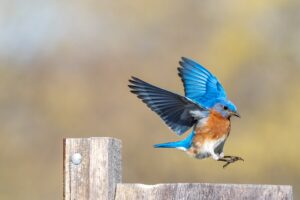
The Eastern Bluebird is always a special sight and finding them can be a delightful birding adventure! Here are some tips to help you increase your chances of spotting these vibrant feathered friends:
Habitat:
- Open areas: Look for Eastern Bluebirds in fields, meadows, farmlands, parks, and open woodlands with scattered trees. They prefer areas with ample space for foraging and perching.
- Nesting sites: These blue beauties often nest in cavities, so keep an eye out for birdhouses, fence posts, hollow trees, and other potential nesting locations.
- Fruit-bearing trees: During breeding season (March-July), they seek insects and berries, so check out areas with fruiting trees like dogwood, mulberry, honeysuckle, and cedar.
Seasonality:
- Year-round residents: Although they might migrate south during harsh winters, some Eastern Bluebirds remain in South Carolina throughout the year.
- Breeding season: Spring and early summer are the best times to spot them, as they’re more active and visible while tending to their nests and young.
Specific locations:
Here are some areas known for Eastern Bluebird sightings in South Carolina:
- Congaree National Park: Offers ample open spaces and diverse habitats with fruiting trees.
- Hilton Head Island: Coastal location with parks and gardens attracting these blue gems.
- Kiawah Island: Similar to Hilton Head, provides suitable habitat and birdwatching opportunities.
- Piedmont Plateau: Rolling hills and farmland areas provide attractive foraging grounds.
- Blue Ridge Mountains: Higher elevations offer suitable habitat, especially during warm weather.
What are the black and orange birds in South Carolina?
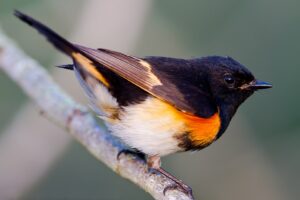
Spotting the vibrant American Redstart in South Carolina requires a keen eye and knowing where to look! These warblers are migratory birds, spending their summers breeding in the state before heading south for the winter. Here are some tips to increase your chances of encountering these feathered jewels:
Habitat:
- Forests and Woodlands: American Redstarts prefer mature deciduous forests with open understory, especially near streams or wetlands. Look for areas with abundant trees like oak, hickory, and magnolia.
- Edge habitats: They often forage along forest edges, where trees meet open fields or meadows. This provides them with easy access to both cover and insects.
- Parks and gardens: While less common, these active birds can sometimes be found in large parks or gardens with mature trees and plenty of insect life.
Seasonality:
- Spring and early summer: April to July is the prime time to see American Redstarts in South Carolina, as they’re actively breeding and raising their young. During this period, they’re more vocal and visible while defending their territories and searching for food.
- Fall migration: Keep an eye out for them again in late September to October as they migrate south for the winter. They might be less vocal but still visible as they refuel for their journey.
Related Articles:
Red, Orange, & Yellow Birds of South Carolina
Feeding winter birds in South Carolina
34 of the most common birds in the United States (with photos)
Please also check out my recommended products page. There I maintain a list of the best feeders, bird foods, binoculars, bird baths, fountains, books and other bird watching items.






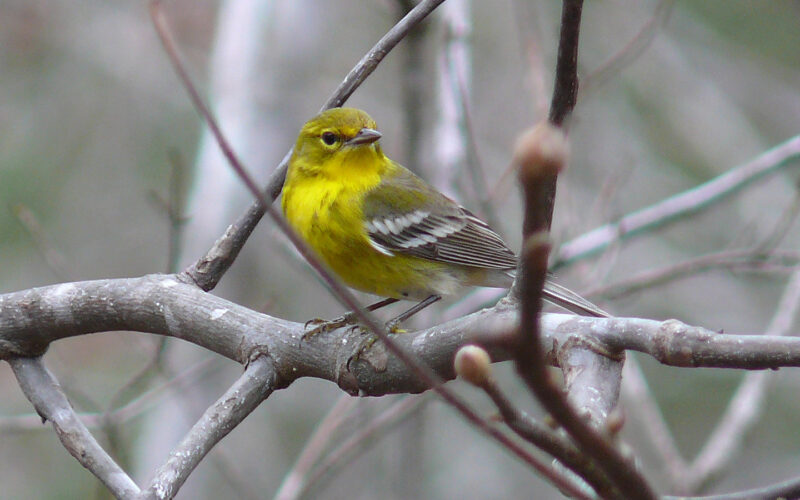
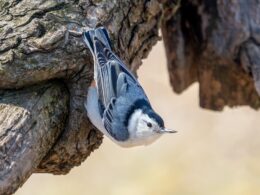
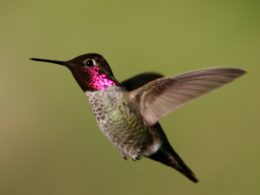
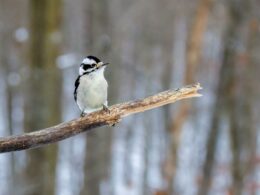
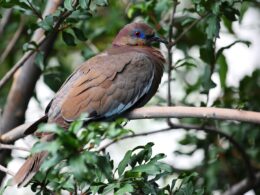
Thank you! Very informative!
Thank you, Timmer!
Just the info I needed as the birds are starting to move in to our new houses. Thank you
You are so welcome! Thanks for taking the time to express your appreciation.